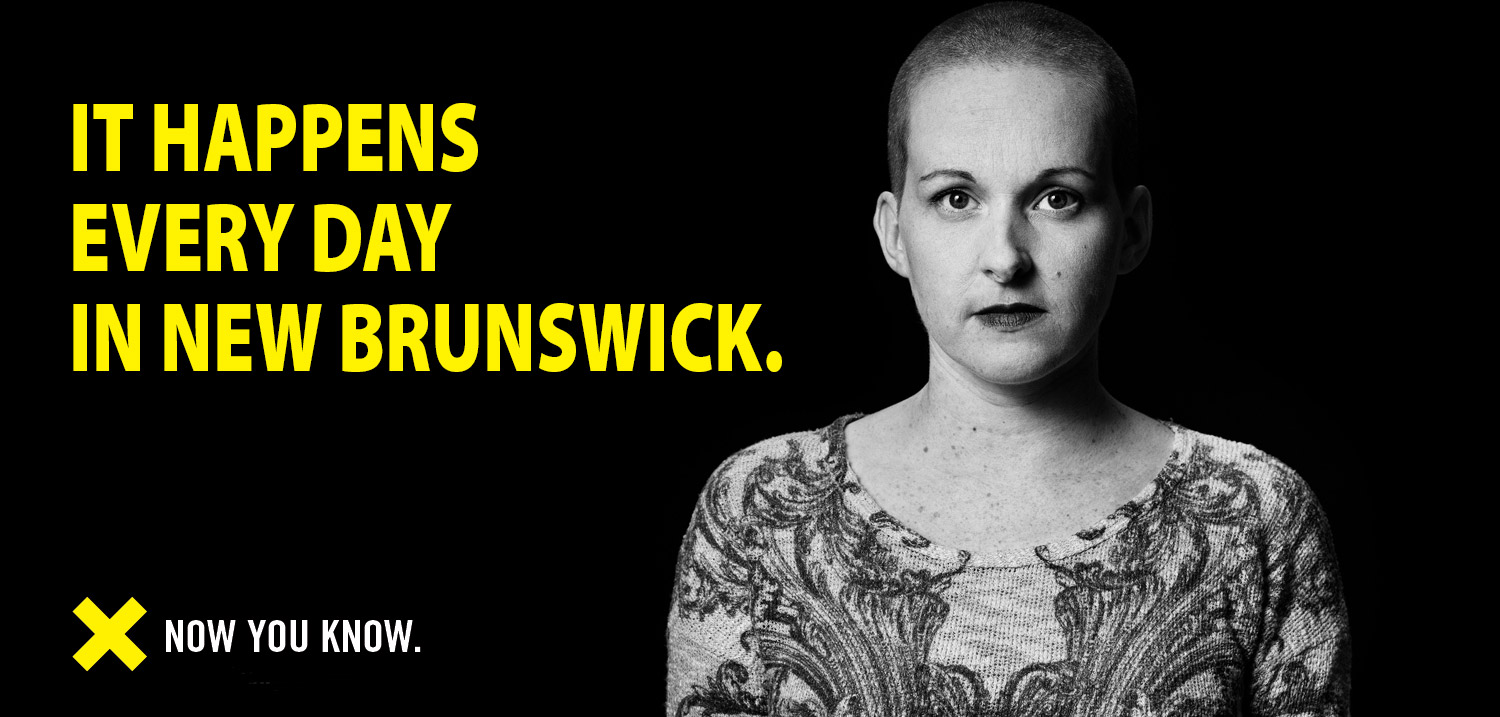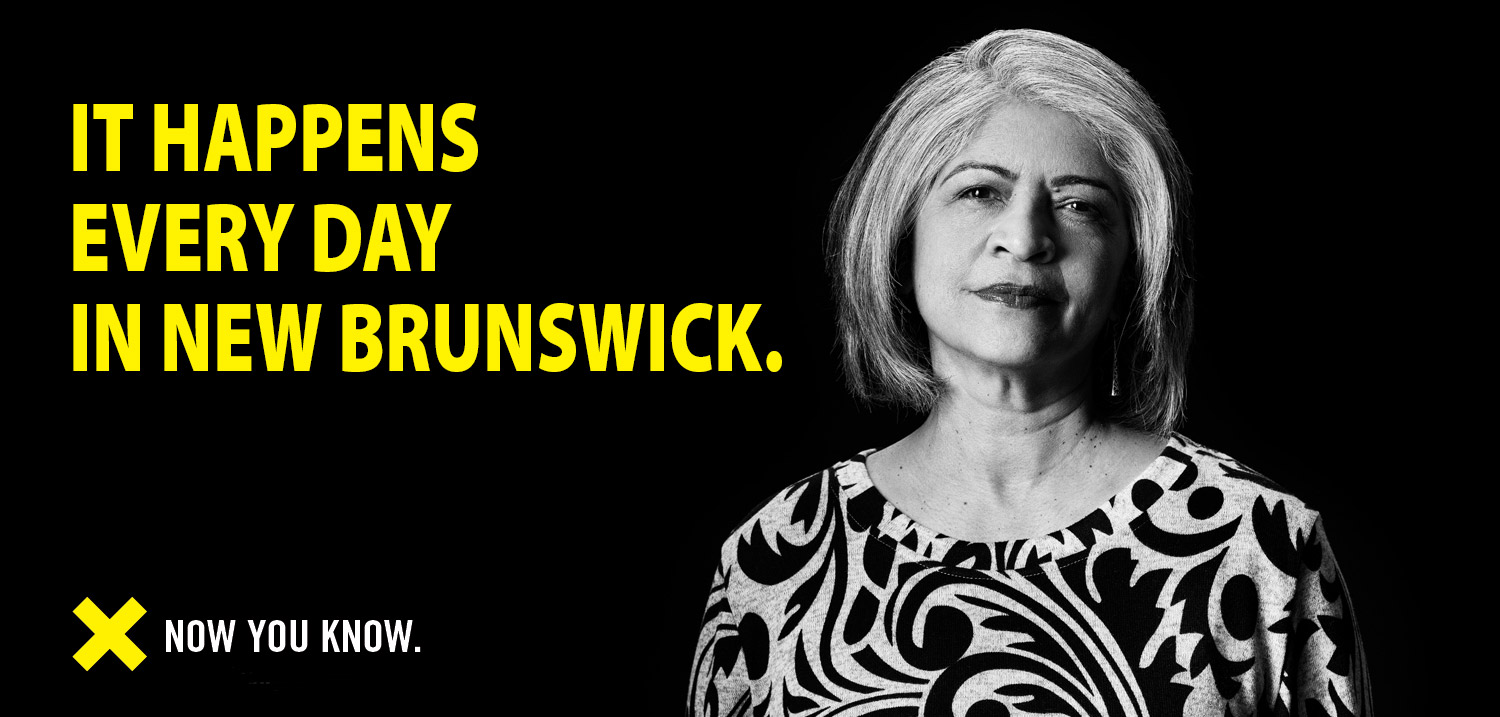WHAT IS SEXUAL VIOLENCE? |
Sexual violence is not about sex. It is about power and control. And it happens every single day in New Brunswick. Sexual violence is any harmful behaviour of a sexual nature which is unwanted and takes place without consent of the survivor.1
Sexual violence, as defined by the World Health Organization (2002)2, is " any sexual act, attempt to obtain a sexual act, unwanted sexual comments or advances, acts to traffic, or otherwise directed, against a person’s sexuality using coercion, by any person regardless of their relationship to the victim, in any setting, including but not limited to home and work."
Coercion can be physical force, and psychological intimidation such as blackmail or other threats (e.g., threat of physical harm, threat of a loss of relationship). Coercion also refers to situations where someone cannot give consent such as when they are drunk, drugged, asleep, or they do not have the mental capacity to understand the situation (WHO, 2002).3
Sexual violence can have long-lasting impacts on survivors. Sexual violence is linked to mental health difficulties (e.g., depression, PTSD), feelings of shame, self-blame, anger, as well as fear, and distressing memories of the experience (DePrince & Gagnon, 2018).4
Myths and stereotypes perpetuate sexual violence. Whether it is street harassment, sexual harassment in the workplace or sexual assault, the person can experience long-term emotional and psychological trauma.

IT HAPPENS EVERY SINGLE DAY IN NEW BRUNSWICK |
In 2018, there were 579 sexual assaults reported to police in New Brunswick (Moreau, 2019)5 and yet less than 1 in 20 incidents (5%) of sexual assault are reported to police in Canada (Perreault, 2015). Sexual violence is a gendered issue as women are more likely to report these experiences than men. In New Brunswick, 87% of the victims of sexual offences were female (Allen and McCarthy, 2018)6 and almost half of these victims were girls under age 18.
Across Canada, the rate of sexual assault is considerably higher for those aged 15 to 24, particularly for women (Conroy & Cotter, 2017).7 Of all sexual assault incidents reported, approximately half (47%) of the victims in these reports were women aged 15 to 24 (Conroy & Cotter, 2017).8 The NB Student Wellness Survey 2015-2016 indicates that 12% of females in grades 6-12 report being sexually violated comparatively to 7% of males in the same grade levels.9
In Canada, those who are First Nations, single, homosexual or bisexual report sexual assault at a higher rate (Conroy & Cotter, 2017).10
The self-reported rate of sexual assault of Aboriginal women and girls is more than three times higher than non-Aboriginal women.11
Now you know.
UNWANTED COMMENTS ABOUT MY BODY ON SOCIAL MEDIA |
Sexual harassment does not just happen in person, it can happen online too. Online, or technology-facilitated, sexual harassment, is a growing problem with the rapid uptake of the internet and social media websites (Henry & Powell, 2018).12 This sexual harassment can occur while playing online games or in tweets about someone's sexuality. Cyberstalking is also a form of online sexual harassment. There are also certain sexting behaviours that are actually sexual harassment. Sexting coercion happens when someone does something sexual via text, pictures or video that they did not want to do. Creating, sharing, or threatening to share "sexts" from other people is also sexual harassment (Drouin & Tobin, 2014).13
Cyberviolence is often around body image. It’s the easiest thing to fall back on when things become confrontational: ‘Oh yeah? Well you’re fat!”. In one study, the participants in a focus group emphasized that young women are commonly targeted online based on sexuality, physical appearance, and weight. “That’s the go to insult” shared a participant, “you’re either a slut, a whore, or you’re fat”. Another participant indicates: “for girls there’s a lot of pressure to look a certain way. And it’s not just seeing [mass] media, but people actually make comments about your body”.14
Now you know.

“As with behaviours in public places, women (18%) were more likely than men (14%) to have experienced an unwanted behaviour that made them feel unsafe or uncomfortable in a virtual space in the past 12 months (Table 1). While the gender gap persisted, it is interesting to note that women were nearly twice as likely to have experienced unwanted behaviours in public places (32%) than they were online (18%). In contrast, men were equally as likely to experience unwanted sexual behaviours online (14%) as they were in public places (13%).”15

SENDING INAPPROPRIATE PHOTOS |
A 2017 American Study found that younger people are often targets of online harassment and that men and women experience online harassment differently. Women are more twice as likely to receive sexualized forms of online abuse and 53% of young women said that someone had sent them explicit images they did not ask for.16
“Young women routinely face a stream of unsolicited and non-consensual intimate images, mass email and spam propositions, descriptions of rape fantasies, and judgmental commentary on their race, sexuality, personality and appearance from men online”.17
Now you know.
“More specifically, the unwanted behaviours most commonly experienced by women online were being sent unwanted sexually suggestive or explicit images or messages (11%) or threatening or aggressive emails or messages (10%) (Table 1; Chart 5). These were also the most common behaviours experienced by men, though the prevalence was lower (6% and 8%, respectively). Though less common, women were also more likely than men to have been pressured to send, share, or post sexually suggestive or explicit images or messages (4% versus 2%).” 18
WHEN I DON'T SAY YES |
A new study from the Canadian Women’s Foundation has found that Canadians’ understanding of consent has decreased over the last three years, with only 28 per cent of Canadians fully understanding what it means to give consent, compared with 33 per cent in 2015.19
Findings from the University of New Brunswick Sexual Assault Climate Survey also indicated that consent must be addressed as 22% of respondents reported some form of sexual coercion (verbal pressure or aggression to engage in sex) while attending UNB.20
For any sexual act/activity to be considered legal both persons must agree to it.
- Consent is only present when a person has clearly said yes. The absence of a no does not mean someone is giving their consent.
- Consent is ongoing; just because someone has said yes to something does not mean they are saying yes to other things.
- Consent is given in the present moment, you cannot pre-consent.
- Consent can be taken away at any time.
Consent CANNOT be given when:
- One person submitted because the other person used threats or force.
- One person submitted because the other person threatened or used force against a third person.
- Lies were used to obtain consent.
- A third party said yes to sex for someone.
- The person being asked to consent is incapable of consenting, for example if they are unconscious.
- The person is a blood relative.
- A child under the age of 12 is one of the partners. Children under 12 are never considered able to consent to sexual activity.
- One person is under 14 years of age and the other person is more than two years older. Children between 12 or more, but under 14 are not considered old enough to consent to sexual activity, with one exception: if two people of this age group consent to sexual activity and there is less than a two-year age difference between them, then the consent is legal.
- Both people are over 12 and under 14 with less than 2 years between them but one person is in a position of trust or authority (e.g. a baby-sitter).
- One person is 14, 15, 16, or 17, and the older person is in a position of trust or authority.
- One person is over 14 years of age but under 16 years of age and the older person is over 5 years older.
Now you know.


UNWELCOME WORDS ABOUT MY SEXUALITY |
According to the 2014 General Social Survey on Victimization, those who identified as lesbian, gay and bisexual (LGB) were twice as likely to report experiencing violent victimization than those who identified as heterosexual.21
Of trans youth surveyed in Atlantic Canada, over half of younger participants ages 14-18 years (61%) reported they had experienced sexual harassment within the past year and nearly one quarter of participants ages 14-25 years (23%) reported being physically forced to have sexual intercourse without consent.
Now you know.
“Half (50%) of all bisexual women had experienced online harassment in the past 12 months, while the prevalence was similar between lesbian women (21%) and heterosexual women (18%). On the whole, being a sexual minority resulted in 1.8 times higher odds of experiencing online harassment among women. (…) As with unwanted behaviours in public places, sexual orientation was the most noteworthy risk factor among men when it came to online harassment as well. Overall, four in ten (40%) bisexual men and more than one-quarter (28%) of gay men had experienced online harassment in the past 12 months. When holding other demographic characteristics constant, being a sexual minority increased the odds of online harassment by 2.8 times for men.” 22
CATCALLING |
Catcalling, a specific form of sexual harassment, is now commonly referred to as street or stranger harassment. Catcalling is unwanted verbal or nonverbal sexual attention from strangers like whistling, yelling lewd comments from cars, winks, and other remarks about people's bodies, sexuality, or sexual orientation (Fisher et al., 2017).23 Approximately 85% of women have experienced catcalling at some point in their lives (Johnson & Sacco, 1995)24, and 28-47% of women experience catcalling at least once every few days (Fairchild & Rudman, 2008;25 Saunders et al., 2016).26
Catcalling is associated with negative outcomes such as symptoms of anxiety and depression, and poorer body image. It is also associated with greater fear of rape and lower levels of feeling safe. As a result, women may change their behaviour to makes themselves feel safer, such as changing routes, avoiding particular places, or avoiding going out at night (Fisher et al., 2017).27
The Canadian Women’s Foundation cites one study that found over half of the Canadian women surveyed had chosen not to go out at night, avoid a city or specific area, and/or change their route or transportation home due to fear of being harassed.28
Now you know.

“Chalk Back” is a global initiative that was started in New York by Sophie Sandberg. Using side-walk chalk, word-for-word comments are transcribed on sidewalks or pavement to draw attention to the profanities and sexualized nature of street harassment. See Cat Calls of Ottawa on Instagram @catcallsofottawa.

“Although not necessarily criminal in nature, these behaviours can have a considerable negative impact on feelings of safety in the daily lives of Canadians. In 2018, one-third (32%) of women and one in eight (13%) men reported feeling uncomfortable or unsafe in public in the past 12 months. The most frequently reported type of unwanted behaviour experienced in public for women was unwanted sexual attention, such as comments, gestures, body language, whistles or calls with more than 3.8 million women experiencing this behaviour in public in the 12 months preceding the survey. For both men and women who experienced these behaviours, a male stranger was the most common perpetrator.”29
NEW BRUNSWICK WOMEN ARE CONCERNED ABOUT SEXUAL VIOLENCE |
From 2017 to 2018, the New Brunswick Women’s Council’s Resonate initiative gathered information and stories from over 1 300 women in New Brunswick.
From this, violence and safety was identified as a top issue that had both affected women’s lives in previous year and that women said needs to be addressed to improve the lives of women in New Brunswick as a group. Of those women who identified violence and safety as a significant issue, 26 per cent specifically named sexual violence.30
Gender inequality and discrimination was another top issue affecting women’s lives and needing to be addressed. When asked if they’d experienced this in the past year, 67 per cent of participants said yes. Many of women’s stories on this issue dealt with sexual harassment.
"I have been sexually assaulted and harassed numerous times. Every time the response of most people is that it was my fault or he didn’t mean any harm.”31
Recent Canadian statistics support these stories, as “the gender gap in victimization was driven by a substantially higher prevalence of sexual assaults experienced by women, who were almost four times more likely to have been sexually assaulted since age 15. Approximately 4.7 million women—or 30% of all women 15 years of age and older—reported that they had been a victim of sexual assault at least once since the age of 15. The prevalence among men was notably smaller, with 1.2 million (8%) men having been sexually assaulted since the age of 15 (Table 6).” 32
“Three in ten women aged 15 years and older have been sexually assaulted at least once since age 15.” 33
References
1 Government of New Brunswick (2018). Preventing and Responding to Sexual Violence in New Brunswick: A Framework for Action. Retrieved online from: https://www2.gnb.ca/content/dam/gnb/Departments/eco-bce/WEB-EDF/Violence/PDF/en/preventing_responding_to_SV_NB-e.pdf
2 Krug, E. G., Mercy, J. A., Dahlberg, L. L., & Zwi, A. B. (2002). The World Report on Violence and Health. Retrieved online from: https://www.who.int/violence_injury_prevention/violence/global_campaign/en/chap6.pdf
4 DePrince, A. P., & Gagnon, K. L. (2018). Understanding the consequences of sexual assault: What does it mean for prevention to be trauma informed? In L. M. Orchowski, & C. A. Gidycz (Eds.), Sexual assault risk reduction and resistance (pp. 15-35). London, UK: Academic Press.
5 Moreau, G. (2019). Police-reported crime statistics in Canada, 2018. Retrieved online from: https://www150.statcan.gc.ca/n1/en/pub/85-002-x/2019001/article/00013-eng.pdf?st=9hC9_5lx
6 Allen, M. & McCarthy, K. (2018). Victims of police-reported violent crime in Canada: National, provincial and territorial fact sheets, 2016. Retrieved online from: https://www150.statcan.gc.ca/n1/en/pub/85-002-x/2018001/article/54960-eng.pdf?st=TebPFsHJ
7 Conroy, S., & Cotter, A. (2017). Self-reported sexual assault in Canada, 2014. Juristat: Canadian Centre for Justice Statistics. Statistics Canada Catalogue no. 85-002-X. Retrieved online from: https://www150.statcan.gc.ca/n1/pub/85-002-x/2017001/article/14842-eng.htm
9 New Brunswick Health Council (2016). New Brunswick Student Wellness Survey 2015-2016 https://nbhc.ca/all-publications/nbsws-grades-6-12-2015-2016
10 Conroy, S., & Cotter, A. (2017)
11 Boyce, J. (2016). Victimization of Aboriginal people in Canada, 2014. Juristat. Statistics Canada. Catalogue no. 85-002-X. Retrieved online from: https://www150.statcan.gc.ca/n1/en/pub/85-002-x/2016001/article/14631-eng.pdf?st=D-xXhXLe
12 Henry, N., & Powell, A. (2018). Technology-facilitated sexual violence: A literature review of empirical research. Trauma, violence, & abuse, 19(2), 195-208.
13 Drouin, M., & Tobin, E. (2014). Unwanted but consensual sexting among young adults. Computers in Human Behavior, 31, 412–418.
14 University of New Brunswick (2015) Behind the Screen: Assessing Needs for the Prevention and Elimination of Cyberviolence against Young Women in New Brunswick. Retrieved online from: https://unbscholar.lib.unb.ca/islandora/object/unbscholar%3A9017/datastream/PDF/view
15 Conroy, S., & Savage, L. (2019). Gender-based violence and unwanted sexual behaviour in Canada, 2018: Initial findings from the Survey of Safety in Public and Private Spaces. Juristat: Canadian Centre for Justice Statistics. Statistics Canada Catalogue no. 85-002-X. (p.11) Retrieved online from: https://www150.statcan.gc.ca/n1/en/pub/85-002-x/2019001/article/00017-eng.pdf?st=NZUGutLH
16 Duggan, M. (2017) Men, women experience and view online harassment differently. Pew Research Centre. ![]() Retrieved online from: https://www.pewresearch.org/fact-tank/2017/07/14/men-women-experience-and-view-online-harassment-differently/
Retrieved online from: https://www.pewresearch.org/fact-tank/2017/07/14/men-women-experience-and-view-online-harassment-differently/
17 Tech Without Violence, dating-apps-without-violence, 2016. Retrieved online from: https://techwithoutviolence.ca/dating-apps-without-violence.
18 Conroy, S., & Savage, L. (2019). Gender-based violence and unwanted sexual behaviour in Canada, 2018: Initial findings from the Survey of Safety in Public and Private Spaces. Juristat: Canadian Centre for Justice Statistics. Statistics Canada Catalogue no. 85-002-X. (p.11) Retrieved online from: https://www150.statcan.gc.ca/n1/en/pub/85-002-x/2019001/article/00017-eng.pdf?st=NZUGutLH
19 Canadian Women’s Foundation (2018). Retrieved online from: https://www.canadianwomen.org/survey-finds-drop-in-canadians-understanding-of-consent/
20 Fuller, R., O’Sullivan, L. and Belu, C. (2016). UNB Sexual Assault Climate Survey. Retrieved online from: https://www.unb.ca/initiatives/_assets/documents/sexualassault/assault-climate.pdf .
21 Simpson, L. (2018). Violent victimization of lesbians, gays and bisexuals in Canada, 2014. Retrieved online from: https://www150.statcan.gc.ca/n1/pub/85-002-x/2018001/article/54923-eng.htm
22 Conroy, S., & Savage, L. (2019). Gender-based violence and unwanted sexual behaviour in Canada, 2018: Initial findings from the Survey of Safety in Public and Private Spaces. Juristat: Canadian Centre for Justice Statistics. Statistics Canada Catalogue no. 85-002-X. (p.12) Retrieved online from: https://www150.statcan.gc.ca/n1/en/pub/85-002-x/2019001/article/00017-eng.pdf?st=NZUGutLH
23 Fisher, S., Lindner, D., & Ferguson, C. J. (2017). The effects of exposure to catcalling on women’s state self-objectification and body image. Current Psychology, 1-8. doi:10.1007/s12144-017-9697-2
24 Johnson, H., & Sacco, V. F. (1995). Researching violence against women: statistics Canada’s national survey. Canadian Journal of Criminology, 37, 281–304.
25 Fairchild, K., & Rudman, L. A. (2008). Everyday stranger harassment and women's objectification. Social Justice Research, 21, 338–357. Retrieved online from: https://doi.org/10.1007/s11211-008-0073-0
26 Saunders, B. A., Scaturro, C., Guarino, C., & Kelly, E. (2016). Contending with catcalling: the role of system-justifying beliefs and ambivalent sexism in predicting women’s coping experiences with (and men’s attributes for) stranger harassment. Current Psychology (Advance online publication). doi: https://link.springer.com/article/10.1007/s12144-016-9421-7
27 Fisher, S., Lindner, D., & Ferguson, C. J. (2017). The effects of exposure to catcalling on women’s state self-objectification and body image. Current Psychology, 1-8. doi:10.1007/s12144-017-9697-2.
28 Fox, Naomi (2016) Street Harassment Isn’t a Compliment. https://www.canadianwomen.org/blog/street-harassment-isnt-a-compliment/
29 Conroy, S., & Savage, L. (2019). Gender-based violence and unwanted sexual behaviour in Canada, 2018: Initial findings from the Survey of Safety in Public and Private Spaces. Juristat: Canadian Centre for Justice Statistics. Statistics Canada Catalogue no. 85-002-X. (p.24) Retrieved online from: https://www150.statcan.gc.ca/n1/en/pub/85-002-x/2019001/article/00017-eng.pdf?st=NZUGutLH
30 New Brunswick Women’s Council (2018). Resonate. Retrieved online from: https://resonatenbresonances.ca/about.
32 Conroy, S., & Savage, L. (2019). Gender-based violence and unwanted sexual behaviour in Canada, 2018: Initial findings from the Survey of Safety in Public and Private Spaces. Juristat: Canadian Centre for Justice Statistics. Statistics Canada Catalogue no. 85-002-X. (p.15) Retrieved online from: https://www150.statcan.gc.ca/n1/en/pub/85-002-x/2019001/article/00017-eng.pdf?st=NZUGutLH









